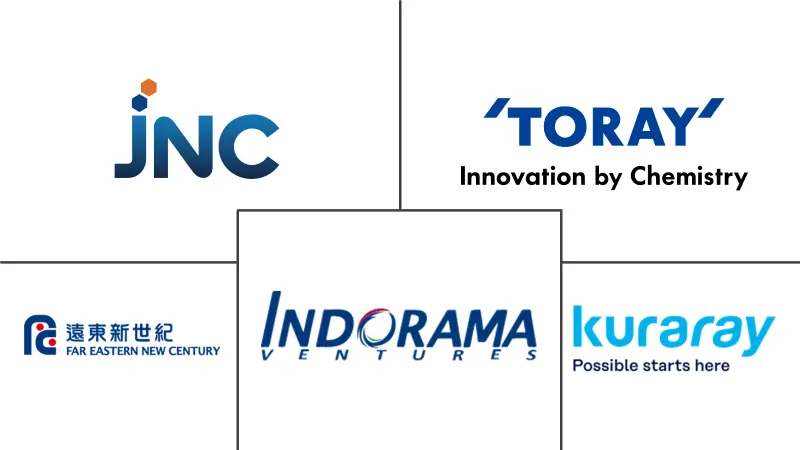Bicomponent Fiber Market Size and Share
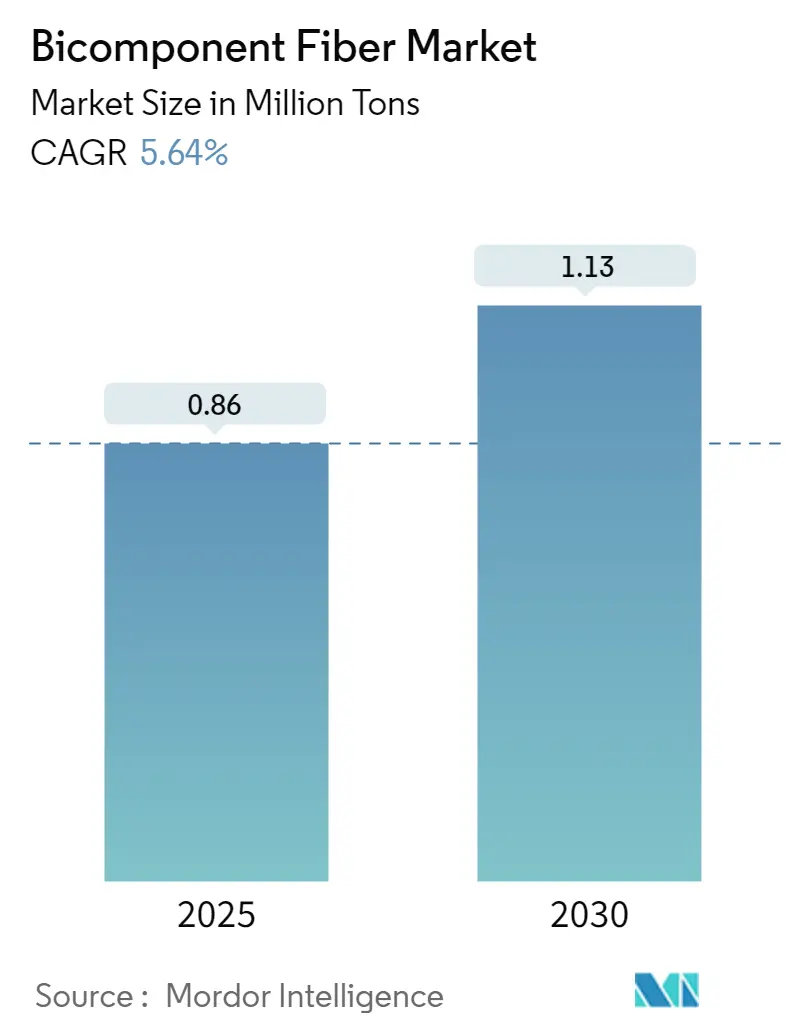
Bicomponent Fiber Market Analysis by Mordor Intelligence
The Bicomponent Fiber Market size is estimated at 0.86 million tons in 2025, and is expected to reach 1.13 million tons by 2030, at a CAGR of 5.64% during the forecast period (2025-2030).
The bicomponent fiber industry is experiencing significant transformation driven by technological advancements and changing consumer preferences across various end-use sectors. The automotive sector has emerged as a crucial market, with China leading global production. According to the China Association of Automobile Manufacturers (CAAM), China produced 27 million vehicles in 2022, highlighting the substantial demand for bicomponent fibers in automotive applications such as interior components, seat covers, and insulation materials. The integration of these fibers in automotive manufacturing has led to enhanced performance characteristics, including improved durability, acoustic properties, and lightweight construction.
The construction industry has demonstrated robust growth, creating substantial opportunities for bicomponent fiber applications. According to the National Bureau of Statistics of China, the construction output value reached a peak of approximately CNY 31.2 trillion in 2022, while the American Institute of Architects (AIA) reported a 9% growth in construction spending during the same year. This growth has driven increased demand for synthetic fiber applications such as concrete reinforcement, insulation materials, and geotextiles, where their unique properties contribute to improved structural integrity and performance.
The personal care and hygiene sector has witnessed significant developments, with major manufacturers launching innovative products and expanding their production capabilities. In April 2023, Petoskey Plastics announced a USD 2 million investment in a new manufacturing line specifically designed for healthcare gowns, with an initial capacity of two million gowns per month. According to EDANA, hygiene and personal care wipes accounted for more than 45% of all nonwoven use across Europe in 2022, demonstrating the sector's significant contribution to bicomponent fiber consumption.
The textile industry is undergoing a transformation with an increased focus on sustainable and high-performance materials. Notable developments include Nike's 2023 collaboration with designer Martine Rose to develop innovative approaches to sportswear that integrate both male and female styles. This trend towards versatile, high-performance textiles has led to increased adoption of textile fiber in athletic wear, outdoor clothing, and fashion applications. The industry has also witnessed significant investments in research and development to enhance fiber properties such as moisture-wicking capabilities, durability, and comfort, driving innovation in textile manufacturing processes.
Global Bicomponent Fiber Market Trends and Insights
GROWING ADOPTION OF BICOMPONENT FIBER IN THE HYGIENE INDUSTRY
The hygiene industry has emerged as a major driver for nonwoven fiber adoption due to the material's unique properties of being clean, recyclable, and providing uniform adhesive distribution. These fibers are extensively utilized in producing engineered fiber nonwoven fabrics with enhanced soft-touch characteristics, making them ideal for various hygiene applications, including infant diapers, feminine care products, adult incontinence products, and medical underpads. The growing awareness regarding infant hygiene has led to increased adoption of baby diapers and wipes, with statistics showing that babies use approximately 6,000 diapers during their first two years of life. This significant usage volume is reflected in the global disposable diaper market, which reached approximately USD 71 billion in 2022, indicating the robust demand for composite fiber in hygiene applications.
The market is witnessing substantial investments and product innovations from major manufacturers, demonstrating the increasing importance of advanced fiber in hygiene products. For instance, in April 2023, Millie Moon launched their luxury diaper brand in Canada, featuring materials engineered with CloudTouch Softness technology for optimal comfort. Similarly, Kimberly-Clark announced the relaunch of its Huggies brand with the new 'Huggies Complete Comfort' range in India in January 2023, emphasizing essential characteristics such as softness and absorbency. According to EDANA, hygiene and personal care wipes accounted for more than 45% of all nonwoven use across Europe in 2022, highlighting the significant role of bicomponent fibers in the hygiene sector.
RISING DEMAND FROM THE NON-WOVEN TEXTILE INDUSTRY
The non-woven textile industry's expanding applications and technological advancements have significantly driven the demand for functional fiber. These fibers are increasingly being utilized in high-performance clothing such as sportswear and activewear, where their unique structural characteristics provide enhanced comfort, performance, and durability. The versatility of polymer fiber in non-woven applications has led to their adoption in various sectors, including technical textiles, automotive textiles, and protective clothing. Major sportswear brands and manufacturers are actively incorporating these materials into their product lines, recognizing their superior properties in terms of moisture management, thermal regulation, and overall performance.
Recent developments in the non-woven textile industry demonstrate the growing importance of composite fiber. For instance, in 2023, Reliance Retail's Performax activewear became the official kit sponsor for the Indian football team, securing exclusive rights to manufacture kits across all formats of the game. This partnership highlights the increasing demand for high-performance textiles in sports applications. The non-woven textile industry's growth is further supported by technological innovations and expanding applications in various sectors. For example, the China Nonwovens and Industrial Textiles Association reported an output of 8.14 million tons of nonwovens in 2022, indicating the robust production capacity and demand for non-woven materials incorporating advanced fiber.
Segment Analysis: Material
Polyethylene/Polypropylene (PE/PP) Segment in Bicomponent Fiber Market
The Polyethylene/Polypropylene (PE/PP) segment dominates the global bicomponent fiber market, commanding approximately 30% of the total market volume in 2024. This segment's leadership position is attributed to its superior properties, including excellent bonding ability, high bonding power with special additives, and enhanced web formation capabilities. PE/PP bicomponent fibers are extensively utilized in hygiene products, particularly in the manufacturing of disposable diapers, sanitary napkins, and other personal care items, where their combination of softness and strength is highly valued. The segment is also experiencing the fastest growth trajectory in the market, driven by increasing demand from the hygiene industry and growing adoption in nonwoven applications. The PE component offers high levels of softness to the nonwoven, while the PP core provides strength and maintains a phthalate-free composition, making it ideal for sensitive applications.
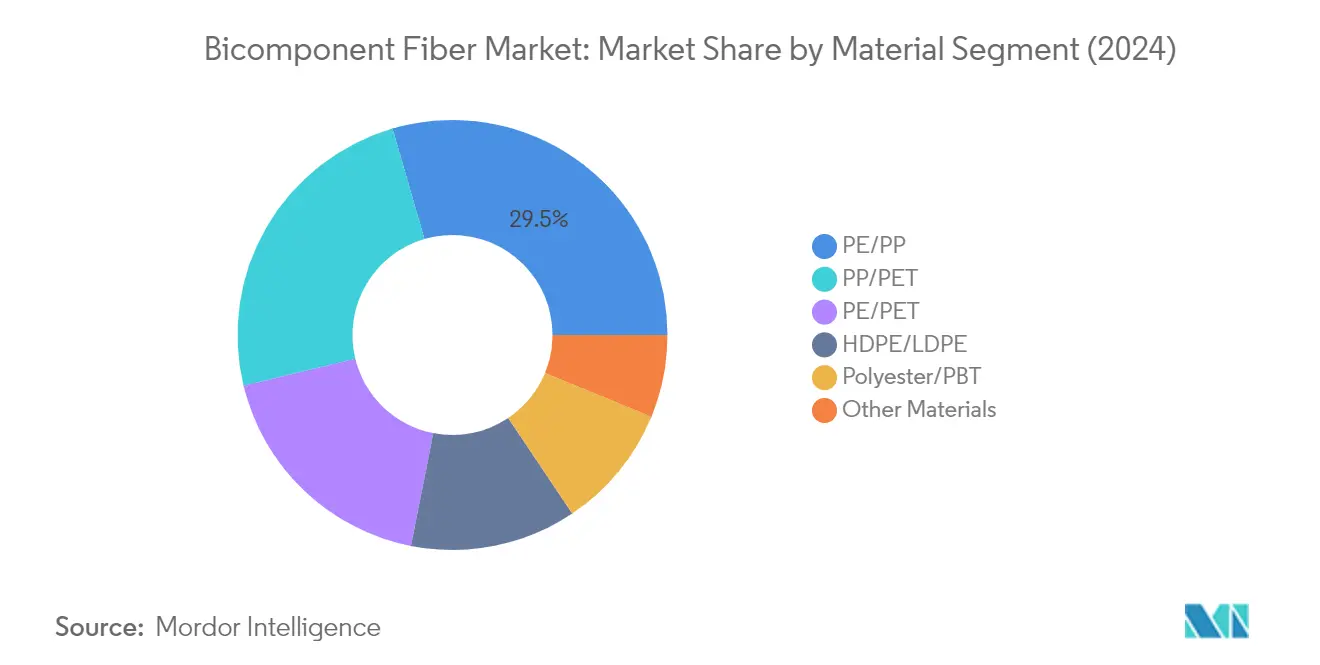
Remaining Segments in Material Segmentation
The bicomponent fiber market encompasses several other significant material combinations that serve diverse applications. The PP/PET segment holds a substantial market position, offering enhanced dyeability and mechanical properties, making it suitable for technical applications. The PE/PET segment provides excellent thermal bonding characteristics and is widely used in various nonwoven applications. The HDPE/LDPE combination leverages the high strength-to-density ratio of HDPE and the stabilizing properties of LDPE, particularly beneficial in specialized applications like 3D printing. The Polyester/PBT segment offers unique characteristics such as dimensional stability and chemical resistance, while other material combinations cater to niche applications requiring specific performance attributes. Each of these segments contributes to the market's diversity by offering unique property combinations that address specific end-user requirements across industries.
Segment Analysis: Structure Types
Sheath-Core Segment in Bicomponent Fiber Market
The sheath-core structure dominates the global bicomponent fiber market, commanding approximately 49% of the total market share in 2024. This structure's prominence can be attributed to its versatility and superior performance benefits, particularly in terms of better strength, softness, and durability. Sheath-core bicomponent fibers are extensively utilized in textiles, hygiene products, and various industrial applications, allowing manufacturers to tailor fiber properties to specific needs. The structure's unique design, where one component fully surrounds the other, enables optimal combination of surface properties with core strength. This configuration is particularly valuable in applications requiring specific surface characteristics while maintaining structural integrity, such as in nonwoven fabrics for hygiene products and technical textiles. The segment's dominance is further reinforced by its ability to provide enhanced bonding capabilities and controlled fiber modifications, making it the preferred choice for manufacturers across multiple end-use industries.
Side-by-Side Segment in Bicomponent Fiber Market
The side-by-side structure segment is emerging as the fastest-growing category in the bicomponent fiber market, projected to grow at approximately 6% from 2024 to 2029. This growth is driven by the structure's unique ability to create self-crimping fibers and its effectiveness in producing splittable fibers for specialized applications. The side-by-side configuration, where two polymers are distributed adjacently along the fiber axis, enables the development of fibers with enhanced elasticity and special functional properties. This structure type is gaining significant traction in applications requiring high-performance characteristics, such as moisture-wicking fabrics and specialized technical textiles. The segment's growth is further supported by increasing demand in emerging applications like smart textiles and advanced material development, where the side-by-side structure's ability to combine different polymer properties is particularly valuable.
Remaining Segments in Structure Types
The islands-in-the-sea and other structure types complete the bicomponent fiber market landscape, each offering unique advantages for specific applications. The islands-in-the-sea structure is particularly valuable in producing ultra-fine fibers and microfibers, finding applications in high-end filtration systems, synthetic leather production, and premium textile applications. This structure type enables the production of fibers with exceptional softness and unique aesthetic properties. Other structure types, including segmented pie and hollow segmented pie configurations, contribute to the market's diversity by offering specialized solutions for specific technical requirements. These structures are particularly important in applications requiring specific mechanical properties or unique cross-sectional characteristics, such as in technical textiles and specialized industrial applications.
Segment Analysis: By End-User Industry
Hygiene Segment in Bicomponent Fiber Market
The hygiene segment continues to dominate the global bicomponent fiber market, commanding approximately 29% of the total market share in 2024. This segment's prominence is primarily driven by the extensive use of bicomponent fibers in manufacturing various hygiene products, including disposable diapers, sanitary napkins, and adult incontinence products. The segment is also experiencing the fastest growth trajectory, projected to expand at around 7% from 2024 to 2029, driven by increasing awareness regarding personal hygiene, growing disposable income, and rising demand for premium hygiene products. Major manufacturers are focusing on developing innovative bicomponent fiber solutions specifically tailored for hygiene applications, emphasizing properties such as enhanced absorbency, improved softness, and better fluid management capabilities. The segment's growth is further supported by the expanding middle-class population in developing economies and increasing adoption of disposable hygiene products across various demographics.
Remaining Segments in End-User Industry
The bicomponent fiber market encompasses several other significant end-user segments, including automotive, nonwoven textile, medical, and construction industries. The automotive sector utilizes composite fibers in manufacturing interior components, providing enhanced durability and aesthetic appeal while meeting stringent industry standards. The nonwoven textile segment leverages these fibers for producing high-performance clothing, including sportswear and protective gear, benefiting from their unique structural properties. The medical sector employs polymer fibers in producing surgical gowns, masks, and wound care products, capitalizing on their superior barrier properties and comfort characteristics. The construction industry utilizes these fibers for concrete reinforcement and insulation applications, taking advantage of their strength and durability properties. Each of these segments contributes significantly to the market's overall growth, driven by technological advancements and increasing applications across various industries.
Bicomponent Fiber Market Geography Segment Analysis
Bicomponent Fiber Market in Asia-Pacific
The Asia-Pacific region represents a dominant force in the global bicomponent fiber market, with significant manufacturing and consumption activities across major economies. China, India, Japan, and South Korea form the cornerstone of the regional market, each contributing distinctively to the industry's growth. The region's prominence is driven by the expanding textile industry, growing adoption in hygiene products, and increasing demand from the automotive sector. The presence of major manufacturers, coupled with advanced manufacturing capabilities and favorable government policies supporting industrial growth, has strengthened the region's position in the global bicomponent fiber market.
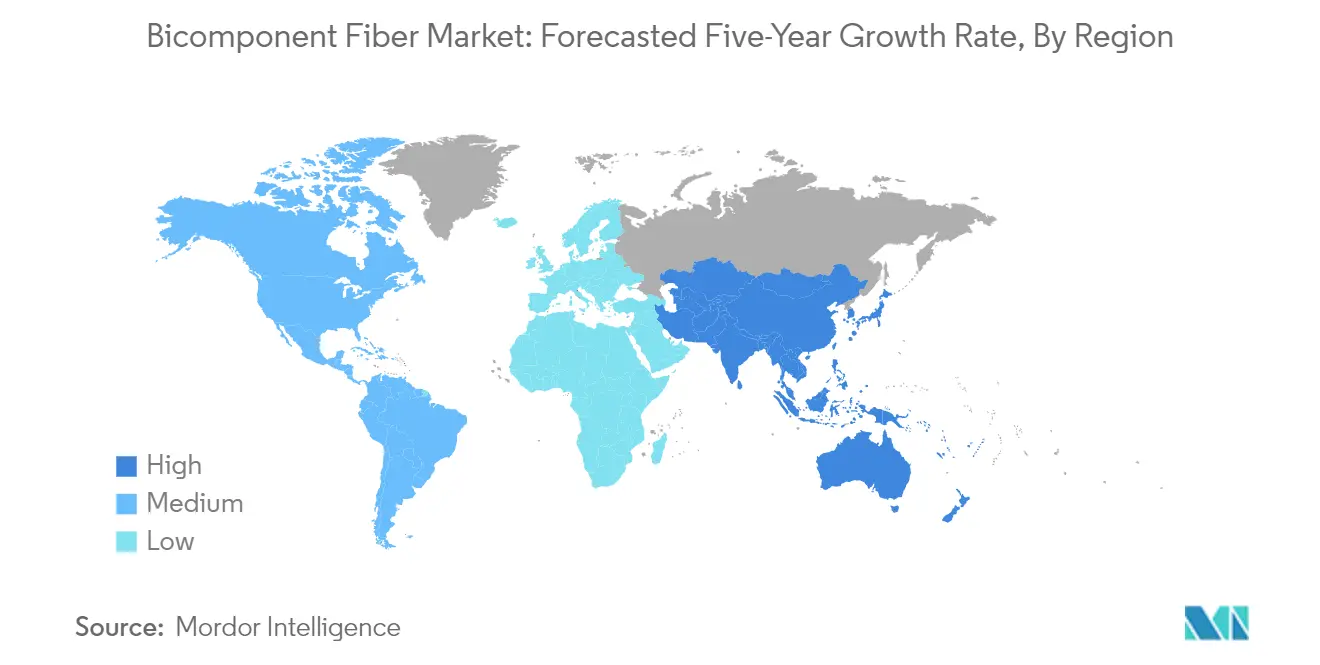
Bicomponent Fiber Market in China
China stands as the powerhouse of the Asia-Pacific bicomponent fiber market, commanding approximately 43% of the regional market share in 2024. The country's dominance is attributed to its robust manufacturing infrastructure and extensive textile industry base. China's market is characterized by the presence of numerous domestic and international manufacturers, particularly concentrated along the east coast in provinces like Shandong, Jiangsu, Zhejiang, Fujian, and Guangdong. The country's strong position is further reinforced by its significant investments in research and development, leading to innovations in synthetic fiber technology and applications.
Growth Dynamics in Chinese Market
China continues to demonstrate remarkable growth potential, with a projected CAGR of approximately 8% during 2024-2029. This growth is driven by increasing domestic demand for hygiene products, expanding automotive industry applications, and rising adoption in technical fiber textiles. The country's focus on sustainable manufacturing practices and technological advancements in fiber production has attracted significant investments. The growing emphasis on high-performance materials in various end-use industries, coupled with the government's support for industrial modernization, continues to fuel market expansion.
Bicomponent Fiber Market in North America
North America represents a sophisticated market for bicomponent fibers, characterized by advanced manufacturing capabilities and high-end applications across various industries. The United States, Canada, and Mexico comprise the key markets in this region, each contributing uniquely to the regional landscape. The market is driven by strong demand from the hygiene products sector, technical fiber textiles industry, and growing applications in the automotive and construction sectors. The region's focus on technological innovation and sustainable manufacturing practices has fostered the development of advanced bicomponent fiber solutions.
Bicomponent Fiber Market in United States
The United States dominates the North American market, holding approximately 71% of the regional market share in 2024. The country's leadership position is supported by its advanced manufacturing infrastructure and strong presence of major industry players. The US market is characterized by high demand from the hygiene sector, particularly in products like diapers and feminine care items. The country's robust research and development activities, coupled with increasing investments in sustainable fiber technologies, have maintained its position as the regional market leader.
Growth Trajectory in United States Market
The United States market is projected to grow at approximately 7% CAGR during 2024-2029, leading the growth in North America. This growth is driven by increasing adoption in industrial fiber textiles, rising demand for sustainable materials, and expanding applications in medical textiles. The country's focus on developing innovative fiber solutions, particularly in high-performance applications, continues to drive market expansion. The growing emphasis on domestic manufacturing capabilities and increasing investments in advanced manufacturing technologies further support market growth.
Bicomponent Fiber Market in Europe
Europe represents a mature market for bicomponent fibers, with a strong focus on technological innovation and sustainable manufacturing practices. The region's market is primarily driven by Germany, the United Kingdom, France, and Italy, each contributing significantly to the market dynamics. The European market is characterized by stringent quality standards, advanced manufacturing capabilities, and high demand for premium quality specialty fiber across various applications.
Bicomponent Fiber Market in Germany
Germany leads the European bicomponent fiber market, leveraging its strong industrial base and technological expertise. The country's dominance is supported by its robust automotive industry, advanced textile sector, and significant investments in research and development. German manufacturers are particularly focused on developing innovative fiber solutions for technical fiber textiles and high-performance applications, maintaining their position at the forefront of technological advancement in the industry.
Growth Prospects in German Market
Germany continues to demonstrate strong growth potential in the European market, driven by increasing demand for industrial fiber textiles and sustainable fiber solutions. The country's focus on Industry 4.0 initiatives and sustainable manufacturing practices has created new opportunities for market expansion. The growing emphasis on developing bio-based and recyclable fibers, coupled with increasing applications in automotive and medical textiles, supports the market's growth trajectory.
Bicomponent Fiber Market in South America
The South American bicomponent fiber market demonstrates growing potential, with Brazil and Argentina emerging as key markets in the region. The market is characterized by increasing investments in manufacturing capabilities and growing demand from various end-use industries. Brazil stands as the largest market in the region, while also showing the fastest growth rate, driven by its expanding textile industry and increasing adoption in hygiene products. The region's market development is supported by growing industrialization, increasing domestic demand, and rising investments in manufacturing infrastructure.
Bicomponent Fiber Market in Middle East & Africa
The Middle East & Africa region presents an emerging market for bicomponent fibers, with Saudi Arabia and South Africa serving as key markets. The region's market is characterized by growing investments in manufacturing capabilities and increasing demand from various end-use industries. Saudi Arabia represents the largest market in the region, while also demonstrating the fastest growth rate, supported by significant investments in industrial infrastructure and growing demand from the hygiene products sector. The region's market development is driven by increasing industrialization, rising domestic demand, and growing focus on diversifying industrial capabilities.
Competitive Landscape
Top Companies in Bicomponent Fiber Market
The global bicomponent fiber market is led by major players including Indorama Ventures Public Company Limited, Far Eastern New Century Corporation, Kuraray Co. Ltd, JNC Corporation, and Toray Industries. These companies focus on expanding their production capacities and developing innovative products to meet the growing demand from partner customers, particularly in the hygiene sector. Strategic collaborations and joint ventures are being pursued to strengthen market positions and enhance technological capabilities. Companies are increasingly emphasizing sustainability through initiatives like recyclable fibers and bio-renewable materials development. The industry is witnessing significant investments in R&D for developing specialized applications across the medical, automotive, and construction sectors. Manufacturing facilities are being strategically located across key regions to ensure efficient supply chain management and better customer service.
Fragmented Market with Strong Regional Players
The bicomponent fiber market exhibits a partially fragmented structure with a mix of global conglomerates and specialized regional manufacturers. Major players are vertically integrated, controlling various aspects of the value chain from raw material production to end-product manufacturing, which provides them significant competitive advantages. The market is characterized by the presence of well-established companies with strong distribution networks and technological capabilities, particularly in Asia-Pacific, where manufacturers benefit from proximity to raw materials and key end-use industries. Companies are increasingly focusing on establishing strategic partnerships with end-users to ensure stable demand and customize products according to specific requirements.
The industry is witnessing strategic consolidation through mergers and acquisitions, particularly in developed markets. Companies are acquiring smaller, specialized manufacturers to expand their product portfolios and geographical presence. Asian manufacturers, especially from China and Japan, are expanding their global footprint through strategic investments and partnerships. The market is seeing increased competition from local players in emerging economies who are investing in advanced manufacturing capabilities and developing innovative products to compete with global players. Market leaders maintain their positions through continuous innovation, strong customer relationships, and efficient supply chain management.
Innovation and Sustainability Drive Future Growth
Success in the bicomponent fiber market increasingly depends on developing sustainable and innovative products that meet evolving customer needs. Companies need to invest in advanced manufacturing technologies and R&D capabilities to develop specialized products for high-growth applications such as hygiene products and medical textiles. Market players must focus on establishing strong partnerships with end-users and maintaining efficient supply chains to ensure consistent product quality and timely delivery. The ability to offer customized solutions and technical support to customers will become increasingly important as applications become more specialized and demanding.
Future market success will require companies to address growing environmental concerns through sustainable production practices and recyclable products. Players must navigate potential regulatory changes regarding environmental impact and product safety, particularly in developed markets. Companies need to maintain cost competitiveness while investing in new technologies and sustainable practices. The ability to serve multiple end-user industries and develop multi-functional products will become crucial for maintaining market position. Regional players can gain ground by focusing on niche applications and developing strong relationships with local customers, while global players must continue to innovate and expand their geographical presence to maintain their market leadership. The synthetic fiber industry is expected to play a crucial role in this evolution, with its advancements in advanced fiber and specialty fiber technologies.
Bicomponent Fiber Industry Leaders
Indorama Ventures Public Company Limited
Far Eastern New Century Corporation
JNC Corporation
KURARAY CO., LTD.
TORAY INDUSTRIES, INC.
- *Disclaimer: Major Players sorted in no particular order
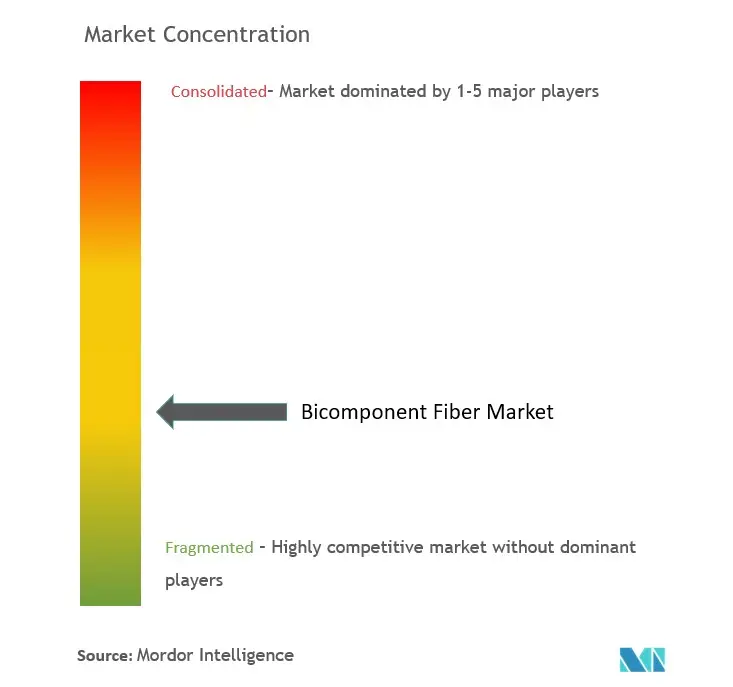
Recent Industry Developments
- October 2022: Teijin Frontier Co. Ltd, a subsidiary company of Teijin Limited, opened a new manufacturing facility for the highly efficient production of polyester filaments. The company invested JPY 1 million (USD 0.01 million) in constructing this facility, and it is expected to produce 1,500 tons of polyester filaments, including bicomponent fiber, annually by the end of the year 2024.
Global Bicomponent Fiber Market Report Scope
Bicomponent fiber, or heterophil fiber, is a special class of synthetic fiber manufactured using two different polymers and then extruded as a single filament. This fiber combines the benefits of two polymers to obtain fibers with unique properties, such as effective thermal bonding, fine fibers, unique cross-section, easy customization, and others.
The bicomponent fiber market is segmented by material (Polyethylene (PE)/Polypropylene (PP), Polypropylene PP/Polyethylene Terephthalate (PET), high-density polyethylene/low-density polyethylene, polyester/polyethylene polyester/PBT, and other materials), structure types (shell-core, side-by-side, islands in the sea, and other structure types), end-user industry (non-woven textiles, automotive, hygiene, construction, medical, and other end-user industries), and geography (Asia-Pacific, North America, Europe, South America, and Middle East & Africa).
The report offers market size and forecasts for bicomponent fiber in terms of volume (tons) and revenue (USD) for all the above segments.
| Polyethylene (PE)/Polypropylene (PP) |
| Polypropylene (PP)/polyethylene Terephthalate (PET) |
| High-density Polyethylene/Low-density Polyethylene |
| Polyethylene/polyethylene Terephthalate (pet) |
| Polyester/PBT |
| Other Materials |
| Sheath-core |
| Side-by-Side |
| Islands in the Sea |
| Other Structure Types |
| Non-Woven Textiles |
| Automotive |
| Hygiene |
| Construction |
| Medical |
| Other End-user Industries |
| Asia-Pacific | China |
| India | |
| Japan | |
| South Korea | |
| Rest of Asia-Pacific | |
| North America | United States |
| Canada | |
| Mexico | |
| Europe | Germany |
| United Kingdom | |
| Italy | |
| France | |
| Rest of Europe | |
| South America | Brazil |
| Argentina | |
| Rest of South America | |
| Middle-East and Africa | Saudi Arabia |
| South Africa | |
| Rest of Middle-East and Africa |
| Material | Polyethylene (PE)/Polypropylene (PP) | |
| Polypropylene (PP)/polyethylene Terephthalate (PET) | ||
| High-density Polyethylene/Low-density Polyethylene | ||
| Polyethylene/polyethylene Terephthalate (pet) | ||
| Polyester/PBT | ||
| Other Materials | ||
| Structure Types | Sheath-core | |
| Side-by-Side | ||
| Islands in the Sea | ||
| Other Structure Types | ||
| End-user Industry | Non-Woven Textiles | |
| Automotive | ||
| Hygiene | ||
| Construction | ||
| Medical | ||
| Other End-user Industries | ||
| Geography | Asia-Pacific | China |
| India | ||
| Japan | ||
| South Korea | ||
| Rest of Asia-Pacific | ||
| North America | United States | |
| Canada | ||
| Mexico | ||
| Europe | Germany | |
| United Kingdom | ||
| Italy | ||
| France | ||
| Rest of Europe | ||
| South America | Brazil | |
| Argentina | ||
| Rest of South America | ||
| Middle-East and Africa | Saudi Arabia | |
| South Africa | ||
| Rest of Middle-East and Africa | ||
Key Questions Answered in the Report
How big is the Bicomponent Fiber Market?
The Bicomponent Fiber Market size is expected to reach 0.86 million tons in 2025 and grow at a CAGR of 5.64% to reach 1.13 million tons by 2030.
What is the current Bicomponent Fiber Market size?
In 2025, the Bicomponent Fiber Market size is expected to reach 0.86 million tons.
Who are the key players in Bicomponent Fiber Market?
Indorama Ventures Public Company Limited, Far Eastern New Century Corporation, JNC Corporation, KURARAY CO., LTD. and TORAY INDUSTRIES, INC. are the major companies operating in the Bicomponent Fiber Market.
Which is the fastest growing region in Bicomponent Fiber Market?
Asia Pacific is estimated to grow at the highest CAGR over the forecast period (2025-2030).
Which region has the biggest share in Bicomponent Fiber Market?
In 2025, the Asia Pacific accounts for the largest market share in Bicomponent Fiber Market.
What years does this Bicomponent Fiber Market cover, and what was the market size in 2024?
In 2024, the Bicomponent Fiber Market size was estimated at 0.81 million tons. The report covers the Bicomponent Fiber Market historical market size for years: 2019, 2020, 2021, 2022, 2023 and 2024. The report also forecasts the Bicomponent Fiber Market size for years: 2025, 2026, 2027, 2028, 2029 and 2030.
